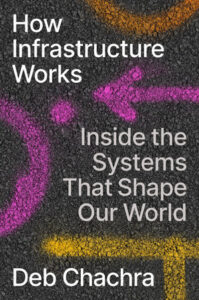 Welcome to the latest installment of “Five words from …” our series which highlights interesting words from interesting books! In this book, Deb Chachra, Professor of Engineering at Olin College of Engineering, helps us explore the hidden beauty and complexity of the infrastructure we take for granted, and outlines how we can transform and rebuild it to be not just functional but also equitable, resilient, and sustainable.
Welcome to the latest installment of “Five words from …” our series which highlights interesting words from interesting books! In this book, Deb Chachra, Professor of Engineering at Olin College of Engineering, helps us explore the hidden beauty and complexity of the infrastructure we take for granted, and outlines how we can transform and rebuild it to be not just functional but also equitable, resilient, and sustainable.
“It also likely means unbuilding structures, whether that’s relocating buildings away from shorelines facing sea-level rise and higher storm surges, or taking up the concrete around urban river and replacing it with bioswales, vegetated channels that absorb stormwater, preventing floods while removing pollutants.”
The Portland Nursery offers a PDF listing plants you can use to create bioswales (or rain gardens) in your own yard.
“A graph of the total exogenous energy usage of humanity (that is, energy from all sources outside our own bodies) over time is flat until about 1800, after which it becomes roughly exponential, starting slowly and then rising more and more steeply.”
The word ‘exogenous’ comes ultimately from Greek roots meaning ‘born’ and ‘outside’.
“Externalities, to economists, are values or costs that aren’t accounted for by the market, because they accrue to someone who isn’t part of the transaction and therefore often has no choice in whether it happens or not.”
This sense of the word ‘externality’ was first used by Alfred Marshall, a British economist, in Principles of Economics, published in 1890.
“While talking through what we had seen over the course of that weekend, Charlie and I landed on the term “ultrastructure” to describe this web of social structures, all of the cultural, political, regulatory, and other systems that shape and govern infrastructure.”
Chachra talks in more depth about the idea of ‘ultrastructure’ in this interview in the excellent Scope of Work newsletter.
“If terraforming is taking an uninhabitable planet like Mars and changing the atmosphere to make an ecosystem capable of supporting life, we are instead taking our perfectly habitable planet and veneriforming it, transforming our terrestrial home into our other planetary next-door neighbor, suffocatingly hot Venus.”
The word ‘veneriform‘ exists in another Venus-related sense: having the shape of the shell of the Venus clam.